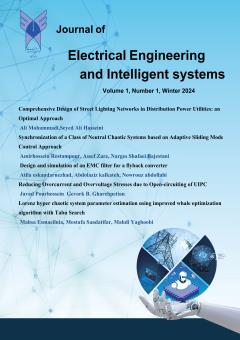Reducing Overcurrent and Overvoltage Stresses due to Open-circuiting of UIPC
Subject Areas : Electrical engineering (electronics, telecommunications, power, control)
Javad Pourhossein
1
*
![]() ,
Gevork B. Gharehpetian
2
,
Gevork B. Gharehpetian
2
![]()
1 - Department of Electrical Engineering, Islamic Azad University (IAU)-Gonabad Br
2 - Department of Electrical Engineering, Amirkabir University of Technology, Tehran, Iran
Keywords: Power flow controller, discontinuous control, overcurrent and overvoltage mitigation,
Abstract :
The unified interphase power controller (UIPC) is basically a series-type power flow controller that behaves like a current source. Hence, an open-circuit fault at the terminal of this device can result in severe stress. The opening of the device terminal results in a dual-branch parallel circuit in each phase (one RL and one RC), which disconnected from the line, and forms a series RLC circuit locally excited by two series voltage source converters (VSCs). This condition has high circulating current and overvoltage at the midpoint i.e., at the open-circuited terminal of the device. These may cause flashovers and serious damages to the device. In this research, a technique based on the discontinuous control of the device is proposed to overcome the mentioned problems. Based on the technique, the injected voltages of two VSCs are immediately reset to zero after an open-circuit fault so that the circulating current and consequently the overvoltage can be reduced. The evaluation of the proposed technique has been done through computer simulations in the Digsilent software environment and then analyzing the results in the form of a curve. In the following, the analysis and comparison of the results have shown that the proposed technique has high efficiency. It should be noted that this technique can be applied to all members of the UIPC family.
[1] D. Chao, F. Wanliang, J. Lin, and N. Shuanbao, “FACTS Devices Allocation via Sparse Optimization,” IEEE Trans. Power Syst., vol. 31, no. 2, pp. 1308-1319, Mar. 2016.
[2] S. Pradeep, and T. Rajive, “Amalgam Power Flow Controller: A Novel Flexible, Reliable, and Cost-Effective Solution to Control Power Flow,” IEEE Trans. Power Syst., vol. 33, no. 3, pp. 2842-2853, May. 2018.
[3] M. O. Lawal, O. Komolafe, and T. O. Ajewole, “Power-flow-tracing-based congestion management in hydrothermal optimal power flow algorithm,” J. Mod. Power Syst. Clean Energy, Jan. 2019, Doi: 10.1007/s4056501804905.
[4] D. Divan, and H. Johal, “Distributed FACTS—A new concept for realizing grid power flow control,” IEEE Trans. Power Electron., vol. 22, no. 6, pp. 2253-2260, Nov. 2007.
[5] T. Ding, R. Bo, Z. Bie, X. Wang, “Optimal Selection of Phase Shifting Transformer Adjustment in Optimal Power Flow,” IEEE Trans. Power Syst., vol. 32, no. 3, pp. 2464–2465, May. 2017.
[6] O. Ziaee , and F. F. Choobineh, “Optimal Location-Allocation of TCSC Devices on a Transmission Network,” IEEE Trans. Power Syst., vol. 32, no. 1, pp. 94–102, Jan. 2017.
[7] M. A. chitsazan, and A. M. Trzynadlowski, “State estimation of IEEE 14 bus with interphase power controller using WLS method,” in Proc. 2016 IEEE Energy Conversion Congr. and Expo. (ECCE), Milwaukee, USA.
[8] M. Farmad, S. Farhangi, G. B. Gharehpetian, and S. Afsharnia, “Nonlinear controller design for IPC using feedback linearization method,” Int J of Elect Power and Energy Syst., vol. 44, no. 1 pp. 778–785, Jan. 2013.
[9] L. Wang, and Q. S. Vo, “Power Flow Control and Stability Improvement of Connecting an Offshore Wind Farm to a One-Machine Infinite-Bus System Using a Static Synchronous Series Compensator,” IEEE Trans. Sustain. Energy, vol. 2, no. 4, pp. 358-369, Apr. 2013.
[10] S. Galvani, M. Tarafdar Hagh, M. B. Bannae Sharifian, and B. Mohammadi-ivatloo, “Multi-Objective Predictability Based Optimal Placement and Parameters Setting of UPFC in Wind Power Included Power Systems,” IEEE Trans. Ind. Informat., Mar. 2018.
[11] J. Pourhossein, G. B. Gharehpetian, and S. H. Fathi, “Static Inter-phase Power Controller (SIPC) modeling for load flow and short circuit studies,” Energy Conversion and Manage. vol. 64, pp. 145-151, Dec. 2012.
[12] J. Pourhossein, G. B. Gharehpetian, and S. H. Fathi, “Unified Interphase Power Controller (UIPC) Modeling and Its Comparison With IPC and UPFC,” IEEE Trans. Power Del., vol. 27, no. 4, pp. 1956-1963, Oct. 2012.
[13] M. Zolfaghari, M. Abedi, and G. B. Gharehpetian, “Power flow control of interconnected AC-DC microgrids in grid-connected hybrid microgrids using modified UIPC,” To be published in IEEE Trans. Smart Grid.
[14] G. Sybille, Y. Haj-Maharsi, G. Morin, F. Beauregard, J. Brochu, J. Lemay, and P. Pelletier, “Simulator demonstration of the interphase power controller technology,” IEEE Trans. Power Del., vol. 11, no. 4, pp. 1985-1992, Oct. 1996.
[15] M. H. Haque, “Improvement of First Swing Stability Limit by Utilizing Full Benefit of Shunt FACTS Devices,” IEEE Trans. Power Syst., vol. 19, no. 4, pp. 1894-1902, Nov. 2004.
[16] P. S. Kumar, “Transient Stability Enhancement of Power System Using TCSC,” Int. J. of Elect. and Comput. Eng., vol. 2, no. 3, Apr. 2012.
[17] E. Uzunovic, C. A. Canizares, Z. Huang, Y. Ni, C. M. Shen, F. F. Wu, S. Chen, and B. Zhang, “Application of Unified Power Flow Controller in Interconnected Power Systems Modeling, Interface, Control Strategy, and Case Study,” IEEE Trans. Power Syst., vol. 15, no. 4, pp. 1461–1462, Nov. 2000.

